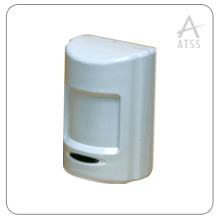SECURITY SYSTEMS SOLUTIONS
PIR Motion Sensor | Intruder Sensor
Who Needs a PIR Motion Sensor?
- Homeowners: Are you looking for a way to add an extra layer of security to your home? PIR motion sensors are a great option for deterring burglars and keeping your family safe.
- Business Owners: Do you want to protect your inventory and property from theft? PIR motion sensors can be used in businesses of all sizes to deter criminals and provide peace of mind.
- DIY Enthusiasts: Are you handy and enjoy taking on home improvement projects? PIR motion sensors are a relatively easy and affordable way to add security features to your home.
What is a PIR Motion Sensor and How Does it Work?
Unveiling the PIR Tech: Passive Detection and Thermal Imaging
A PIR motion sensor, also known as a passive infrared sensor, is an electronic device that uses infrared technology to detect movement. It works by continuously monitoring the infrared (heat) radiation levels in its field of view. When a warm object, such as a human body, moves within the sensor’s range, it disrupts the pattern of infrared radiation, triggering the sensor.
- Passive Detection: Unlike radar sensors that emit their own energy waves, PIR sensors are passive devices. They don’t emit any type of radiation; instead, they detect the infrared radiation that is naturally emitted by objects in their surroundings.
- Thermal Imaging: Imagine the sensor creates a constant thermal image of its environment. This image includes everything within the sensor’s field of view, and any changes in temperature will be registered.
- Triggering the Alarm: When a person enters the sensor’s zone and moves around, their body heat disrupts the thermal image. This change is what triggers the sensor and activates the connected alarm system or lighting.
Where Can PIR Motion Sensors Be Used?
PIR motion sensors are a versatile security tool that can be used in a variety of locations, including:
- Homes: Common placements include entryways, hallways, basements, and garages.
- Businesses: They can be used in offices, warehouses, retail stores, and more.
- Outdoors: PIR sensors can be used to protect patios, decks, and other vulnerable areas around your property.
When Should You Consider Using a PIR Motion Sensor?
There are many reasons to consider using a PIR motion sensor, including:
- Enhanced Security: PIR sensors deter burglars by creating a sense of uncertainty. Intruders know they risk setting off an alarm if they enter a protected area.
- Peace of Mind: Knowing your home or business is protected by a security system can give you peace of mind, especially when you’re away.
- Automatic Lighting: PIR sensors can be used to control lighting, automatically turning lights on when motion is detected and off when there’s no activity. This can save energy and improve convenience.
How to Use PIR Motion Sensors
PIR motion sensors are relatively easy to install and use. Here’s a general overview of the process:
- Choose the Right Sensor: Consider the size of the area you want to protect and the desired range of the sensor.
- Placement is Key: PIR sensors should be mounted strategically to cover entry points and high-traffic areas. Avoid placing them near heat sources or vents, as these can trigger false alarms.
- Setting Up the System: Most PIR sensors connect to a security system or lighting control panel. Follow the manufacturer’s instructions for proper configuration.
- Testing and Maintenance: Test your PIR motion sensors regularly to ensure they are functioning properly. Keep the sensor lenses clean and free of dust or cobwebs.
Beyond Basic Detection: Advanced PIR Motion Sensor Features
While basic PIR sensors simply detect motion, some advanced models offer additional features, such as:
- Pet Immunity: These sensors can differentiate between humans and small pets, reducing the likelihood of false alarms caused by your furry friends.
- Dual Technology Sensors: These combine PIR technology with another detection method, such as microwave, for more reliable intrusion detection.
- Wireless Connectivity: Some PIR sensors connect wirelessly to your security system or smartphone, allowing for remote monitoring and control.
Going Beyond the Basics: Unleashing the Full Potential of PIR Motion Sensors
We’ve established that PIR motion sensors are a powerful tool for security and automation. But what if you could unlock their full potential? This section dives deeper into maximizing the effectiveness and usability of PIR motion sensors in your home or business.
Optimizing Placement for Maximum Coverage
- Strategic Zones: Target high-priority areas like entry points (doors and windows). Consider hallways, basements, and garages for additional coverage.
- Mind the Ceiling Height: Most PIR sensors have a specific detection range that depends on mounting height. Consult the manufacturer’s guide for optimal placement.
- Minimize False Alarms: Avoid heat sources like vents or windows with direct sunlight. Similarly, keep them away from high-traffic pet areas to reduce pet-induced triggers.
- Creeping Zones: Some sensors offer adjustable detection zones. Utilize these to create narrow detection areas that cover specific points of entry, like doorways or windows.
Customization and Automation for Enhanced Security and Convenience
- Sensitivity Adjustments: Most PIR sensors allow for adjusting sensitivity to minimize false alarms from minor movements.
- Exit and Entry Delays: Program delays for exiting and entering to prevent the alarm from triggering accidentally when you come and go.
- Smart Home Integration: Many PIR sensors work with smart home systems. Automate lighting to turn on when motion is detected and off when there’s no activity for energy savings and convenience.
- Remote Monitoring and Control: With Wi-Fi connected sensors, receive alerts and control your security system remotely using your smartphone for ultimate peace of mind.
Choosing the Right PIR Sensor for Your Needs
- Wired vs. Wireless: Wired sensors offer a more reliable connection, while wireless are easier to install but may have a shorter range. Consider your needs and technical expertise.
- Detection Range: Choose a sensor with a range that adequately covers the desired area. Remember, walls and furniture can impact detection zones.
- Pet Immunity: If you have pets, a sensor with pet immunity can significantly reduce false alarms.
- Additional Features: Consider features like dual technology sensors for increased reliability or weatherproof casings for outdoor use.
Remember:
- Regular Maintenance: Test your PIR sensors periodically and keep the lenses clean for optimal performance.
- Battery Replacements: For wireless sensors, replace batteries according to the manufacturer’s recommendations to avoid power disruptions.
Beyond Security: Unexpected Uses for PIR Motion Sensors
While security is a primary function, PIR sensors offer surprising versatility:
- Automated Lighting: Use them in closets, cabinets, or pantries to automatically turn on lights when you enter and turn them off when you leave, providing convenience and saving energy.
- Elderly Care: Strategically placed sensors can monitor activity levels in a home with elderly residents, potentially indicating falls or unusual inactivity.
- Smart Pet Monitoring: Use sensors to create alerts when your pets enter restricted areas or when they haven’t been active for an extended period.
By understanding the intricacies of PIR motion sensors and implementing these tips, you can transform your living or working space into a more secure, convenient, and even informative environment.


 Access Control
Access Control Automatic Door
Automatic Door Baggage Scanner
Baggage Scanner Bell Timer
Bell Timer Boom Barrier
Boom Barrier Burglar Alarm
Burglar Alarm Canteen Management
Canteen Management CCTV ANPR
CCTV ANPR CCTV People Counting
CCTV People Counting CCTV Surveillance
CCTV Surveillance CCTV Video Analytics
CCTV Video Analytics Central Vacuum Cleaner
Central Vacuum Cleaner DFMD
DFMD Electric Fence
Electric Fence EAS
EAS Fire Alarm
Fire Alarm Fire Hydrant
Fire Hydrant Fire Suppression
Fire Suppression Flap Barrier
Flap Barrier Garage Door
Garage Door Gas Detector
Gas Detector Gate Automation
Gate Automation GSM Communicator
GSM Communicator Guard Monitoring
Guard Monitoring HHMD
HHMD Home Automation
Home Automation Home Theatre
Home Theatre Hotel Lock
Hotel Lock ID Cards
ID Cards Lighting Automation
Lighting Automation Network & Communication
Network & Communication Nurse Calling System
Nurse Calling System Occupancy Sensor
Occupancy Sensor PA Systems
PA Systems Payroll
Payroll Road Blocker
Road Blocker Smart Lock
Smart Lock Time Attendance
Time Attendance Tripod Turnstile
Tripod Turnstile UVSS
UVSS Video Door Phone
Video Door Phone Parking Management System
Parking Management System Visitor Management
Visitor Management Wireless Communication
Wireless Communication